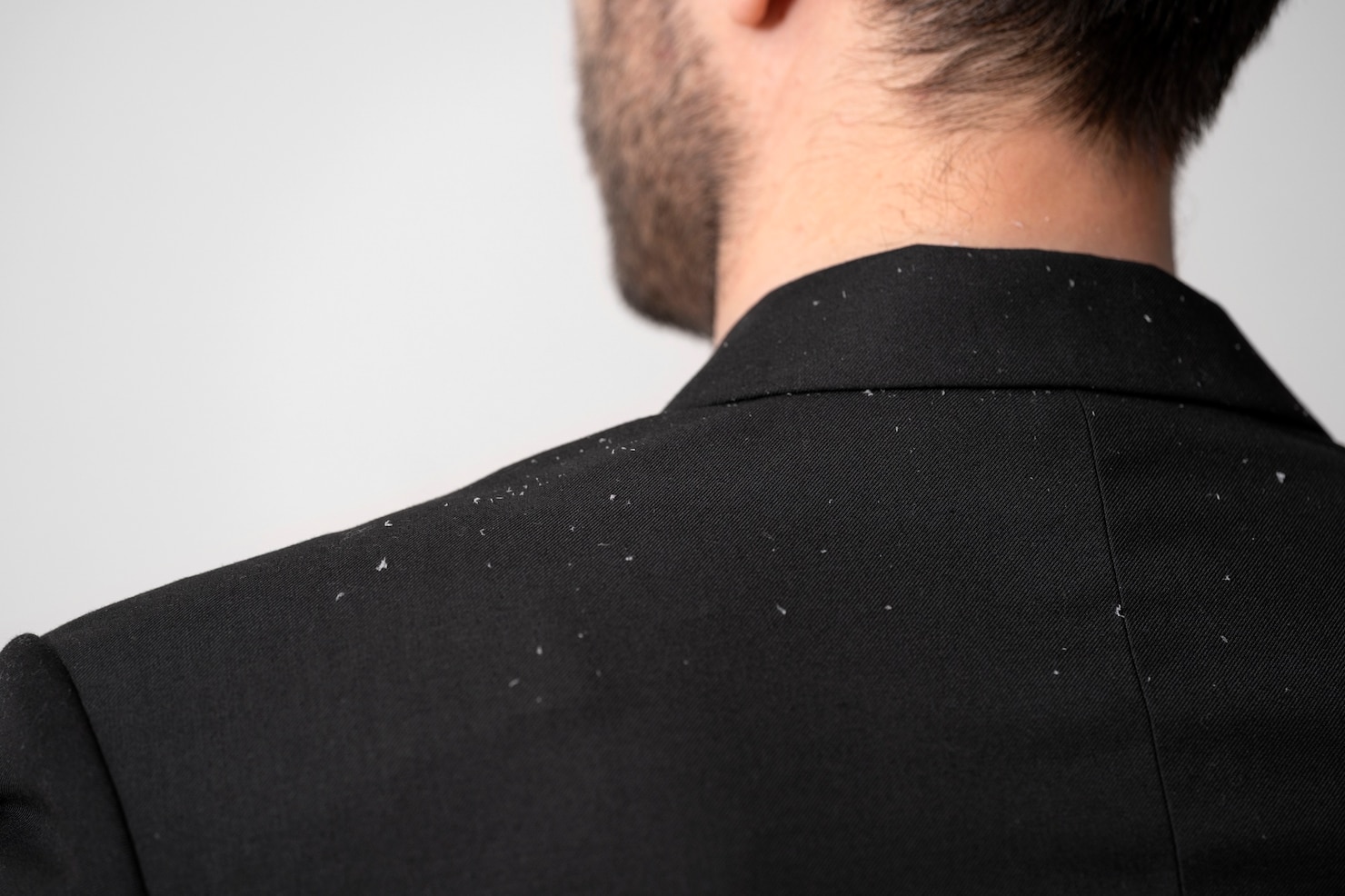
Dandruff is a common scalp condition that affects millions of people worldwide, causing itching, flaking, and discomfort. In this blog post, we will delve into the scientific facts about men's hair care, exploring the causes of dandruff, the potential for transmission, and the best strategies for managing this pesky problem.
Get ready to unlock the truth about dandruff so you can get a reliable answer to “is dandruff contagious?” No more endless searches of “dandruff contagious” or “can dandruff be contagious” – let's dive in and banish dandruff for good!
Introduction to Dandruff
What is dandruff?
Dandruff is a common scalp condition characterized by the shedding of dead skin cells from the scalp. These dead skin cells mix with the natural oils produced by the scalp, resulting in the formation of white or yellowish flakes. While dandruff itself is harmless and not contagious, it can be embarrassing and cause discomfort due to itching and irritation.
Common misconceptions about dandruff.
Contrary to popular belief, dandruff is not caused by poor hygiene. It is actually a result of various factors, including:
- Dry Skin:
Dry skin is a common cause of dandruff. When the scalp lacks moisture, it becomes dry and flaky, leading to dandruff formation.- Seborrheic Dermatitis:
This is a common skin condition that causes redness, greasy scales, and itching. It often affects areas with a high concentration of oil glands, including the scalp. Seborrheic dermatitis can contribute to the development of dandruff.- Malassezia:
Malassezia is a type of yeast-like fungus that naturally resides on the scalp. In some individuals, an overgrowth of this fungus can lead to irritation and excessive shedding of skin cells, resulting in seborrheic dermatitis/dandruff.- Sensitivity to Hair Care Products:
Certain hair care products, such as shampoos or conditioners, may contain harsh ingredients that can irritate the scalp and trigger dandruff.
It is important to note that dandruff is a common condition that affects people of all ages and hair types. While it may not pose a significant health risk, it can have a negative impact on the self-esteem and overall well-being.
Key Takeaway:
Dandruff is a scalp condition characterized by the shedding of dead skin cells. It is not caused by poor hygiene, but rather by factors such as dry skin, seborrheic dermatitis, the presence of Malassezia fungus, or sensitivity to hair care products. Understanding the true nature of dandruff can help dispel misconceptions and guide appropriate treatment and management approaches.Causes and Risk Factors
Malassezia yeast: The primary culprit.
One of the main causes of dandruff is the presence of a yeast-like fungus called Malassezia on the scalp. Malassezia is a naturally occurring microorganism that feeds on the oils produced by the scalp. In some individuals, an overgrowth of this fungus can occur, leading to an inflammatory response and increased shedding of skin cells.
This excess shedding manifests as dandruff flakes. The interaction between Malassezia yeast and the scalp's natural oils plays a significant role in dandruff formation.
Other factors contributing to dandruff.
While Malassezia yeast is the primary cause of dandruff, several other factors can contribute to its development:
- Sebum Production:
Excessive sebum production, which occurs in conditions like seborrheic dermatitis, can create an ideal environment for Malassezia to thrive. The abundance of sebum provides nourishment to the fungus and promotes its growth.- Scalp Sensitivity:
Some individuals have a more sensitive scalp, making them prone to dandruff. Scalp sensitivity can be triggered by factors such as allergies, irritants in hair care products, or changes in weather conditions.- Poor Hair Hygiene:
While dandruff itself is not caused by poor hygiene, inadequate hair care practices can worsen the condition. Infrequent washing or improper cleansing may lead to the buildup of oil, dead skin cells, and product residues on the scalp, exacerbating dandruff symptoms.It is important to note that dandruff can occur in people of all ages and hair types. Certain factors, such as stress, hormonal changes, or compromised immune function, can also influence the development or severity of dandruff. Understanding these causes and risk factors can help in identifying appropriate treatment strategies and lifestyle modifications to manage dandruff effectively.
Key Takeaway:
Dandruff is primarily caused by an overgrowth of the Malassezia yeast on the scalp. Other contributing factors include sebum production, scalp sensitivity, and poor hair hygiene. Recognizing the causes and risk factors associated with dandruff can guide individuals in adopting effective preventive measures and treatment approaches to alleviate symptoms and maintain a healthy scalp.Understanding Dandruff Transmission

Image Source: FreePik
Is dandruff contagious?
No, dandruff is not contagious. It is important to dispel the common misconception that dandruff can be transmitted from person to person through direct contact or sharing personal items.
Dandruff is primarily a scalp condition caused by various factors such as yeast overgrowth, dry skin, or sensitivity. It is not caused by bacteria or viruses that can be easily spread. Therefore, you can rest assured that you cannot contract dandruff from someone else or pass it on to others.
Modes of dandruff transmission clarified.
Since dandruff is not contagious, it cannot be transmitted through casual contact or shared items. Dandruff is a self-contained condition that occurs on an individual's scalp. The shedding of skin cells and the presence of dandruff flakes are confined to the affected person's scalp area. You do not have to worry about contracting dandruff by using the same comb, brush, or hair accessories as someone with dandruff.
It is essential to understand that dandruff is a common condition that affects many people. If you have dandruff, it is not a reflection of your personal hygiene or cleanliness. It is simply a result of factors like yeast overgrowth or dry scalp. By maintaining good scalp hygiene, using appropriate hair care products, and following a regular cleansing routine, you can effectively manage and minimize dandruff symptoms.
Key Takeaway:
Dandruff is not contagious and cannot be transmitted from person to person. It is a self-contained scalp condition caused by factors like yeast overgrowth, dry skin, or sensitivity. Understanding that dandruff is not contagious allows you to focus on appropriate management strategies without worrying about spreading the condition or being affected by others.Managing Dandruff Effectively

Image Source: FreePik
Regular hair washing and cleansing techniques.
One of the key strategies for managing dandruff effectively is maintaining a regular hair-washing routine. Washing your hair at least two to three times a week with a gentle, dandruff-fighting shampoo can help control the symptoms.
When washing your hair, focus on thoroughly cleansing the scalp, where dandruff originates. Massage the shampoo into your scalp using your fingertips, ensuring that it reaches all areas. Leave the shampoo on for a couple of minutes before rinsing it out. This allows the active ingredients in the shampoo to work on reducing dandruff and addressing its underlying causes.
Essential hair care practices to reduce dandruff.
In addition to regular hair washing, adopting a few essential hair care practices can aid in reducing dandruff:
Avoid Harsh Hair Products:
Opt for gentle, mild hair care products that are specifically formulated for dandruff-prone scalps. Avoid products that contain harsh chemicals or irritants that can further aggravate the scalp.Keep the Scalp Moisturized:
Dryness can contribute to dandruff, so it is important to keep the scalp moisturized. Consider using a moisturizing conditioner or incorporating a scalp oil treatment to nourish and hydrate the scalp.Brush and Comb Carefully:
When brushing or combing your hair, do so gently to avoid excessive pulling or irritation of the scalp. Use a clean brush or comb and regularly clean them to prevent any potential buildup.By following these hair care practices and incorporating them into your routine, you can effectively manage dandruff and minimize its symptoms. It is important to remember that consistency is key, and results may take time to become noticeable. If your dandruff persists or worsens despite these measures, it is advisable to consult a dermatologist for further evaluation and guidance.
A dermatologist will prescribe you antifungal shampoos and might give you salicylic acid based products and even mild topical steroids in cases of advanced stages of seborrheic dermatitis. Having said that, do not introduce any medicated product into your hair care routine before consulting a skin specialist.
Key Takeaway:
Managing dandruff effectively involves regular hair washing and cleansing techniques, such as using a dandruff-fighting shampoo and thoroughly massaging it into the scalp. Essential hair care practices, including using gentle hair products, moisturizing the scalp, and being mindful when brushing or combing, can also help reduce dandruff. Consistency in these practices is important, and if dandruff persists, seeking professional advice is recommended.Conclusion
Dandruff is a common scalp condition that can be effectively managed with the right approach. By understanding the nature of dandruff, including its causes, misconceptions, transmission, and effective management techniques, you can take proactive steps to alleviate its symptoms and maintain a healthy scalp. Remember that dandruff is not contagious and cannot be transmitted from person to person. It is a self-contained condition that requires individual attention and care. Regular hair washing, gentle cleansing techniques, and adopting essential hair care practices can play a significant role in reducing dandruff and promoting a healthier scalp. Additionally, it is important to seek professional guidance if dandruff persists or worsens despite these measures. With proper management and consistent care, you can effectively control dandruff and enjoy a more comfortable and confident hair and scalp condition.


